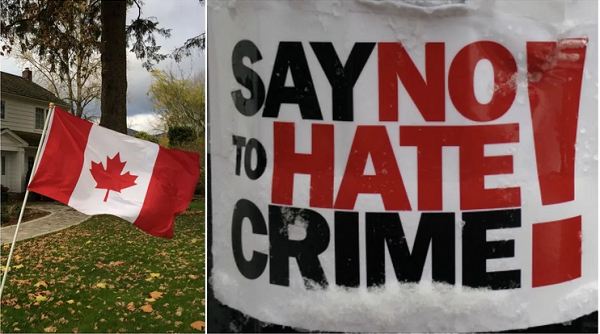StatCan report finds hate crimes in Canada against certain groups of people have increased tremendously
The number of hate crimes in Canada centred on race or ethnicity rose for the fourth consecutive year in 2022, according to the latest report on hate crimes by Statistics Canada.
Crimes against Black victims accounted for most of the 12 per cent increase in race-based hate crimes that year, while the number of hate crimes targeting sexual orientation also rose by 12 per cent, increasing for the second consecutive year. Advocates for the Black and LGBTQ2S+ communities in Canada say they’re not surprised by these trends – they see these crimes and their consequences play out in real-time.
“We see it on the ground, we see it in the number of calls that we get on a daily basis, we see it in the news reports, we see it online,” said Danette Edwards, acting general counsel at the Toronto-based Black Action Legal Centre, in a phone interview with CTVNews.ca.
“So I think it’s not surprising. It’s saddening and it’s disappointing and it’s distressing. But surprising? No.”
Moreover, StatCan notes that the report likely underestimates the number of hate crimes that occurred in Canada in 2022, since the data only reflects crimes reported to police.
As Helen Kennedy knows well, many hate crimes are never reported. Canada’s Justice Department estimates only one in 10 are ever reported to the criminal justice system.
Kennedy, executive director of LGBTQ2S+ advocacy group Egale Canada, said members of the community often don’t feel safe or comfortable reporting hate crimes to police.
“They don’t want to be outed. They don’t want to be shamed,” she told CTVNews.ca in a phone interview. “There’s a secondary victimization when you go to the police service. They may not take you seriously.”
The numbers we do have
Despite gaps, StatCan’s reporting sheds some light on the growing frequency of hate crimes targeting specific communities in Canada in recent years.
Police-reported hate crimes targeting Black victims increased by 28 per cent, or 182 incidents, year-over-year in 2022, and more hate crimes targeting Black people were committed than crimes targeting any other race or ethnic group.
Overall, incidents targeting the Black population accounted for more than half – 57 per cent – of the increase in racial or ethnic hate crimes in 2022.
Hate crimes targeting the South Asian population also increased in 2022 for the third consecutive year, rising 143 per cent from 2019 to 2022, including an 18 per cent rise from 2021 to 2022.
Violent hate crimes – including simple assault, uttering threats and major assault – increased 12 per cent in 2022, while the number of victims of hate-related homicides rose from 15 in 2021 to 23 in 2022.
The number of hate crimes targeting religious groups dropped by 15 per cent year-over-year in 2022, but is likely to have risen again since the onset of the Israel-Hamas war, as cities across the country have reported spikes in crime against members of the Muslim and Jewish communities in recent months.
Hate crimes are legally defined in Canada as criminal offences committed against people or property based on the victims’ race, religion, nationality, ethnic origin, sexual orientation, gender or disability. The Criminal Code of Canada’s definition of hate crimes encompasses a wide range of crimes, from assault and vandalism to hate speech.
“So many of our clients come to us having been assaulted verbally or physically due to the fact that they are Black, either by security officers, by the police, in the workplace (or) in a store,” said Edwards, whose office provides free legal services to Ontario’s Black communities.
“The expressions are very wide and far ranging, but I think almost every client that has come through our door has experienced some form of hate crime.”
These crimes, Edwards said, can have a profound impact on victims’ mental health, sense of safety and sense of belonging. She’s seen victims calmly sit down to tell their stories, only to be reduced to sobs in the end. Some victims of hate crimes experience such profound mental health effects, Edwards said, that their work performance, school performance, and relationships with friends and family can also suffer, leading to mounting societal effects.
“There’s a huge effect on the mental health of the individual who’s had the experience, but also, the difference between the hate crimes and other crimes, I think, is that the entire community feels it,” Edwards said.
“It’s not just the offence against Bob or Jim. It’s an offence against the entire Black community.”
Kennedy has seen this process at work within the LGBTQ2S+ community, too, in how “it perpetuates this sense of fear and of being unsafe.”
Of the 491 hate crimes targeting a sexual orientation recorded in 2022, nearly three-quarters – 74 per cent – specifically targeted the gay and lesbian population. The remainder targeted “people of another sexual orientation that is not heterosexual, such as asexual and pansexual people,” the bisexual population and victims whose “sexual orientation was reported as unknown.”
While StatCan won’t release 2023’s numbers until later this year, Kennedy said it’s apparent that hate directed toward certain members of the LGBTQ2S+ community has intensified since 2022.
“Right now, we’re seeing a huge rise in anti-trans rhetoric and violence across North America,” she said.
‘People feel entitled’
Last month, the Canadian Security Intelligence Service warned that the LGBTQ2S+ community could face an ongoing threat of serious violence by extremists throughout 2024. The warning came amid a countrywide debate over Alberta’s plan to limit access to gender-affirming care for transgender youth.
Kennedy blames anti-trans policies and political leaders who make transphobic comments for some of the rise in anti-LGBTQ2S+ violence in Canada over the last year or so.
“I think what’s driving it is people feel emboldened to commit these crimes. They feel supported by their political leaders who are espousing some of this rhetoric,” she said. “People feel entitled to say and do whatever they like against the queer community.”
As for the rise in reports of anti-Black hate crimes, Edwards thinks at least some of that increase might be down to Black victims feeling more confident reporting hate crimes to law enforcement in the years following the death of George Floyd and the rise of the Black Lives Matter movement in 2020.
But, she said, there are other major factors likely at play too.
“The pandemic obviously contributed substantially, as we can see from the numbers,” she said. “And I think also people felt a lot more comfortable expressing their opinions of hatred under the sort of free speech umbrella.”
Countering these factors, both Kennedy and Edwards agreed, will require more proactive anti-hate education across the country.
“I think if we started with the education system, we stop the violence and the bullying within the school system, I think that would go a long way to helping to address some of these issues at the root cause,” Kennedy said.
Then there’s the legal dimension. While Canada’s Criminal Code defines and outlaws a number of hate-motivated offences, Edwards said the criminal justice system is poorly equipped to prosecute hate crimes.
“The problem is with enforcement,” she said.
According to StatCan, of all the hate crimes reported to police in 2022, less than a third were solved, compared with 34 per cent of all criminal incidents – excluding traffic-related crimes – reported to police that year.
“So once you report a hate crime to the police, how much resources do they have to dedicate to prosecuting these people?” Edwards said. “The criminal justice system is overburdened, and so very little attention is paid to these crimes.”
This article was first reported by CTV News













